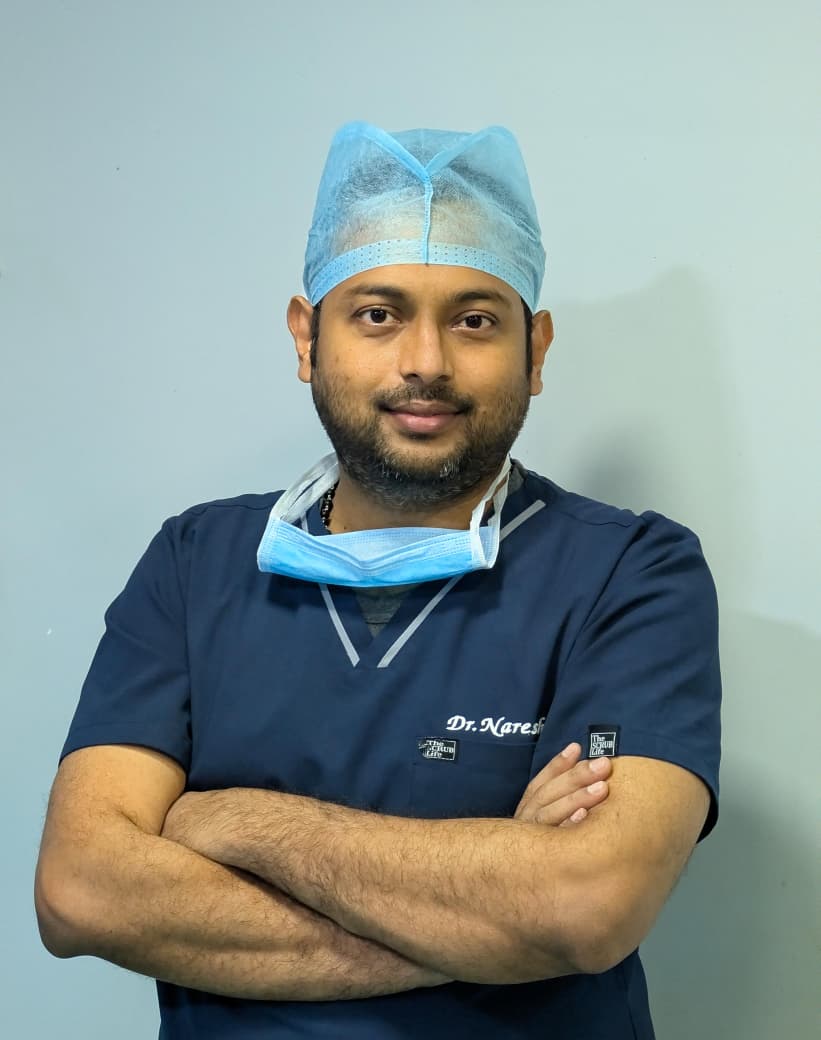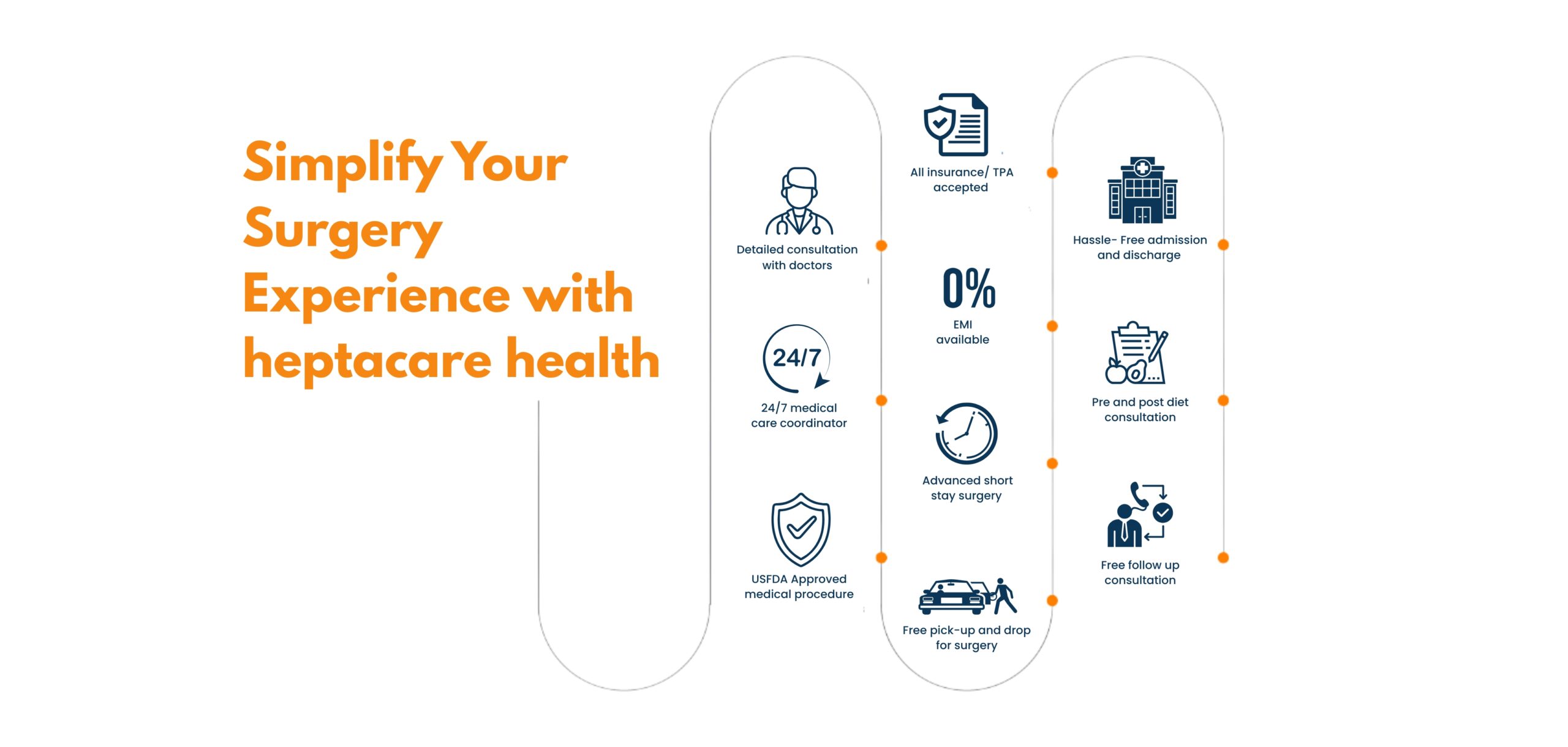A sebaceous cyst is a small, noncancerous lump beneath the skin caused by blocked sebaceous glands, often filled with oily or keratin material.
Is your child born with a cleft lip? Consult HeptaCare Health esteemed plastic surgeons and get their help to create a customized cleft lip treatment plan for your child. We provide safe and advanced surgical treatment for unilateral and bilateral Cleft Lip Surgery. Book a consultation with our expert plastic surgeons.
Happy Patients
Disease
Hospitals
Cities
A cleft lip is a congenital condition in which there is a split or gap in the upper lip. It occurs during early pregnancy when the tissue that forms the lip does not fully come together. This can result in a visible gap or opening in the lip, and it can range in severity from a small notch to a larger gap that extends into the nose.
Cleft lip and palate are among the most common birth defects. The classification of a cleft lip is as follows:
Cleft lips can often be detected through prenatal ultrasounds, and they are usually addressed through surgical repair. Through the various techniques of cleft lip surgery, the surgeon will focus on recreating the lip’s natural “Cupid’s Bow” shape, adjusting the lip structure, normalizing the symmetry of nostrils, and masking the scar. To learn all about cleft lip treatment, call HeptaCare Health and talk to our expert doctors.
Children who are born with a cleft often require a tailored cleft lip treatment plan to meet their individual needs. The typical care plan for cleft lip looks like this.
Throughout the growth period, the child needs to attend regular outpatient appointments with the doctor for proper monitoring of the problems.
Prior to cleft lip treatment, several important diagnoses and evaluations are typically conducted to ensure the best possible outcome for the patient. These assessments help the doctor to understand the severity of the cleft, the overall health of the patient, and any potential complications that might arise during or after surgery. Here are some of the key evaluations:
Once the assessments are done, the surgeon will present the treatment and repair plan to the parents, disclose the risks and complications, and also give an idea of what to expect after surgery. The family is educated and informed well enough to have realistic expectations and prepare themselves for the challenges and care involved with Cleft Lip Surgery.
A cleft lip surgery is a procedure to correct the deformity in the upper lips. It is also called cheiloplasty or lip revision surgery. The goal of cleft lip treatment is to repair the cleft and restore the sphincter function of the orbicularis oris muscle. The procedure also focuses on the cosmetic aspect to ensure normal growth of the lip. If the cleft lip presents with a cleft palate, too, cleft lip surgery may also be combined with a cleft palate repair.
Most plastic surgeons believe that the best age for a child to undergo cleft Lip Surgery is between 10 and 12 weeks. This age is advantageous for patients as early surgery ensures that the cleft doesn’t develop further or in an abnormal manner. Moreover, the patient will heal quickly and won’t remember the recovery process. If the surgery is delayed, there is a higher risk of patients developing speech disorders.
In some cases, there may be some contraindications of Cleft Lip Surgery, due to which the surgery may get delayed. This may happen if further workup of the patient’s health and underlying conditions is required or if the patient has other conditions whose surgical treatment is more important.
There are a few different techniques used for Cleft Lip Surgery, depending on the severity and type of cleft. The two main types of Cleft Lip Surgery surgery are the Millard Rotation-Advancement Technique (also known as the “Millard Technique”) and the Tennison-Randall Technique. These techniques differ in their approaches to closing the cleft and achieving a more natural lip appearance.
Besides the above-mentioned techniques, some other methods are also used to improve the outcomes of Cleft Lip Surgery, such as a lip-taping regimen, nasal elevator, and nasal-alveolar molding (NAM) device. These methods are non-invasive and can dramatically enhance the shape and appearance of the child’s upper lip, nose, and mouth.
Cleft Lip Surgery offers numerous benefits to individuals born with cleft lips. These benefits extend beyond the cosmetic aspect and greatly impact both physical and emotional well-being. Here are some of the key benefits of cleft lip repair:
It should be noted that Cleft Lip Surgery alone may not be sufficient for all patients born with a cleft lip and/or palate. Future surgical interventions, speech therapy, orthodontic treatments, etc., may be required.
Several pre-operative instructions are given to the patient’s family to ensure his/her safety, comfort, and the surgery’s success. The specific instructions might vary based on the treatment plan and the child’s health. Some common instructions given by the surgeon may include the following:
If the child becomes ill (has a cough, cold, or fever), notify the surgeon and his/her team right away so that the surgery can be postponed.
The procedure for Cleft Lip Surgery involves several steps, and the specific details may vary based on the surgeon’s technique, the severity of the cleft, and the individual patient’s needs.
In the case of unilateral cleft, only one surgery is required. But if the child has bilateral cleft and it’s extensive, two surgeries may be performed. One side of the cleft is corrected first, and the second side is corrected a few weeks later. The most common procedure to repair a cleft lip is the Millard technique, whose steps are explained below in detail.
The entire Cleft Lip Surgerymay take around 1 to 2 hours or more, depending on the severity of the condition and the type of repair done. In the case of bilateral Cleft Lip Surgery, a second surgery will be performed similarly or through a different technique to correct the deformity in the upper lip completely.
Immediately after the surgery, expect the child to feel mild pain. He/she might be irritated, and the treated area will be swollen and bruised.
Soft splints or cuffs are placed around the child’s arm to prevent them from touching his/her lip. This can further make the child uncomfortable and agitated. It is safe to feed breastmilk or formula shortly after the surgery, but there might be some difficulty in doing so.
An intravenous catheter will be attached to the child to give him/her fluids until he/she can drink. In most cases, hospitalization is not needed after cleft lip surgery. Thus, the child is discharged after a few hours, and the parents are given detailed instructions for post-operative care.
The results of cleft lip surgery will take some time to become clearly visible due to the bruising, swelling, and redness around the lips. As the child heals, the results will become more apparent. The results and recovery timeline will be as follows:
As the recovery process will take around 2 to 4 weeks, the parents will have to be extra attentive to care for the child to ensure a smooth recovery and successful outcome. The outcome will be determined based on how well the parents take care of the child. Therefore, it is important to follow the doctor’s instructions.
Undergoing Cleft Lip Surgery is critical for the child’s development and quality of life. But that doesn’t mean that the surgery is risk-free. There are several risks and complications associated with the procedure. Thus, the surgeon will explain them in detail, and the parents are asked to sign the consent form to confirm that they fully understand the procedure and its potential risks and complications.
Other than these, there are some side effects of cleft lip surgery, such as bleeding, bruising, swelling, and redness around the lips, nose, and cheeks. Typically, the surgeon takes the potential complications into consideration while planning the procedure and recommends certain measures to reduce the risk of developing these complications. Still, some complications may develop, and the child may require additional care.
Once the cleft lip is repaired, both parents will have to take a proactive approach to the child’s care to ensure a successful outcome of the surgery and prevent future complications. The recommended tips required, but are not limited to the following:
Parents are also asked to look out for the signs of infection or other post-op complications, which include trouble breathing, wheezing, skin discoloration, unresponsive, or seizure-like activity.
In India, cleft lip surgery costs range from Rs. 30500 to Rs. 60000 or more. The overall cost of Cleft Lip Surgery depends on multiple factors and varies from one patient to another. The key factors that influence cleft lip surgery cost in India are
To get a specific cost estimate for cleft lip surgery, get in touch with HeptaCare Health.
A cleft lip is a serious medical condition, and its treatment is deemed medically necessary under all circumstances. Thus, the expenses of the clef lip surgery are covered by health insurance.
However, there are several requisites that parents need to follow to get their child’s treatment covered under health insurance. These requisites include:
To learn more about the available insurance plans for newborn children, it’ll be best to talk to the health insurance provider.


Based on 7721 Recommendations | Rated 4.68 Out of 5
Happy Patients
Clinics
Cities
Surgeries
Doctors
Hospitals

A beard transplant is a cosmetic procedure that restores or enhances facial hair by transplanting hair follicles from the scalp to the beard area.

Vaginoplasty is a surgical procedure that tightens or reconstructs the vaginal canal to improve function, appearance, or both.

Treat anal fistula with safe, advanced procedures.
Minimally invasive care with faster recovery.

A breast lump is a swelling or mass in the breast that can be benign (non-cancerous) or, in some cases, a sign of breast cancer.

A tummy tuck, or abdominoplasty, is a cosmetic surgery that removes excess fat and skin from the abdomen and tightens the muscles for a flatter, firmer tummy.

A double chin is a layer of excess fat beneath the chin, often caused by weight gain, ageing, or genetics, and can be reduced through cosmetic treatments or lifestyle changes.

A sebaceous cyst is a small, noncancerous lump beneath the skin caused by blocked sebaceous glands, often filled with oily or keratin material.

A lipoma is a soft, benign lump made up of fatty tissue that grows slowly under the skin and is usually painless and harmless.

Liposuction is a cosmetic surgery that removes excess fat deposits from specific body areas to improve body shape and contour.

Lipomas are soft, moveable, and grow slowly; imaging may confirm.
No, lipomas usually remain or grow slowly over time.
They can be removed by surgery, liposuction, or sometimes steroid injections.
Yes, some people inherit a tendency to develop multiple lipomas.
● lipoma laser surgery cost in Vizag ● low-cost lipoma surgery in Hyderabad ● cashless lipoma treatment near me ● painless lipoma surgery in Vijayawada ● lipoma treatment with insurance in Vizag ● lipoma removal surgery cost in Hyderabad ● lipoma operation packages in Vijayawada ● affordable lipoma treatment near me ● lipoma laser treatment clinic in Hyderabad ● lipoma doctor consultation charges in Vizag ● best lipoma surgery cost in Vijayawada ● lipoma treatment hospital near me ● lipoma laser operation price in Hyderabad ● low-cost lipoma laser treatment in Vizag ● lipoma removal cost near me ● lipoma treatment with EMI in Vijayawada ● lipoma surgery specialist near me ● lipoma surgery packages in Hyderabad ● lipoma treatment clinic near me ● lipoma laser surgery near me
Disclaimer: **The result and experience may vary from patient to patient.. ***By submitting the form or calling, you agree to receive important updates and marketing communications.
Getting an accurate diagnosis can be one of the most impactful experiences that you can have.

cure with care
Copyright © 2025. All rights reserved.
Consult with our expert surgeon for more than 50+ diseases
Happy Patients
Hospitals
Cities